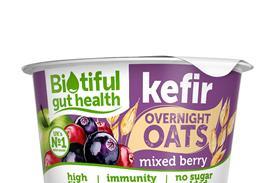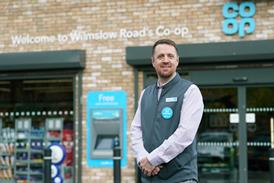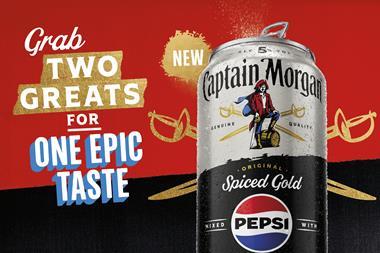Prevent your soft drinks sales from going flat by focusing on big brands, new lines, strong promotions and pricemarks, advises Robin Mannering
There’s good news and bad when it comes to soft drinks sales last year. On the positive side, the soft drinks market in the convenience sector is thriving. The impulse channel grew by 7% in value to £6.6bn in 2010, reversing a -3% decline the previous year and overtaking growth in the grocery channel, according to Britvic’s Soft Drinks report 2011. The growth was driven by an increasing number of shoppers supplementing supermarket trips with more visits to their local convenience store, as declining levels of disposable income left them demanding value for money.
Britvic customer managing director Murray Harris says: “In 2010, soft drinks continued to go from strength to strength in the take-home channel, in spite of economic uncertainty. Although people continued to be extremely careful about where and how they spent their money, they clearly saw soft drinks as an affordable treat, especially for those big nights in.”
retailer’s view
“The category is performing well, especially sport and energy drinks. In fact, we’re having the peaks we were having last summer. Euroshopper’s energy drink has been flying off the shelves over the past few months and I expect the energy market to keep rising. We’re also selling lots of water and flavoured brands are growing all the time.
“Pricemarked products are making a difference, on cans and 500ml bottles. Otherwise, it’s surprising how much products are rising in price due to VAT and petrol prices, yet sales are still good. Maybe people don’t have the money to do large supermarket shops so come to us to do smaller shops more often.”
Ian Mitchell, The Village Store, Ayrshire
But now for the bad news: impulse multiples were responsible for that 7% growth. Independents saw a 2% drop in value in soft drinks sales, and a 4% drop in volume. “The increasing presence on the high streets of Tesco Metro, M&S Food and Sainsbury’s Local provided a wake-up call to the impulse sector,” says Britvic’s soft drinks report. “Smaller convenience stores have to up their game by offering better promotions and improving shopper experience.”
Yet the rise in top-up shopping presents a real opportunity for independents to reverse their declining share of the market. C-Store research shows there is an appetite among retailers to improve the category according to its annual Product Performance Survey (C-Store, April 1), the soft drinks category is the one that the most independent retailers will be focusing on developing this year, with 10% saying they plan to give it more space in store.
Kate Fletcher, Britvic business unit director, impulse, says consistency, innovation and value are essential for retailers to get on top of the category. “Focus on the core brands, but also pick up the innovation that’s exciting for the customer. Be consistent so people know what they’re going to get, and offer ongoing promotions,” she says. “Disciplined impulse players make excellent use of promotions.”
GSK category controller Mark Sterratt agrees that the resurgent impulse sector is being driven by those providing offers. “I’m confident about the sector,” he says. “Get the right range and offer value and you’ll prosper.”
Both retailers and manufacturers are putting more emphasis than ever on pricemarked packs (PMPs). Tom Fender of HIM says independent retailers now strongly believe PMPs are good for their business. This is likely to be further reinforced over the next few months as disposable income becomes reduced by the increase in VAT and rising fuel and food prices.
Ian Mitchell, an independent Ayrshire retailer, says PMPs on cans and 500ml bottles in particular are making a lot of difference, while GSK’s Thirst for Knowledge report (HIM 2010) found that 70% of people are more likely to purchase a product with a pricemark.
Coca-Cola Enterprises (CCE) wholesale trade manager Darren Goldney says there is definitely a growing trend for PMP, although he acknowledges that “it’s got to be done at the right margin for retailers”.
CCE will be launching Coca-Cola 1.25ltr bottles with a £1 PMP in May, which will be a “good opportunity to shout value”, Goldney says. Saqib Ghafoor of Nisa in Gateshead, Tyne & Wear, says a two-for-one Coke promotion through Nisa resulted in a 1,200% uplift in sales for him.
While pricemarks make a difference to sales, so does what you stock, and retailers may need to reassess their ranges. About 60% of category sales come from the top 10 brands (AC Nielsen December 2010) and 80% of sales come from just 20% of products. By prioritising best-sellers retailers can boost sales by 8%, according to GSK’s Thirst For Knowledge Report. Amanda Gragham, head of brand marketing at Shloer, agrees that the duplication of products takes up valuable space which could otherwise be used to offer a wider variety of soft drinks, covering different usage occasions. “Increase facings of the biggest and fastest-selling brands, and include new and emerging brands,” she advises.
top tips
In March a cross-section of industry bodies signed up to a Responsibility Deal, bringing retailers, manufacturers, government and health groups together in the promotion of healthy eating and drinking. All the major soft drink manufacturers have signed up, alongside the Association of Convenience Stores and retailers large and small.
The British Soft Drinks Association (BSDA) says the practical detail is still under discussion, but the aim is to make it easier for people to follow a balanced diet. “This is likely to encompass actions relating to providing information, redesigning recipes (in some cases), and encouraging people to take action,” says BSDA media director Richard Laming. “Each company will adopt a course of action appropriate to its own product range.”
There are also actions with a broader relevance, such as promoting physical activity and healthier lifestyles among the companies’ own employees.
Given that more than 60% of soft drinks contain no added sugar, education and information rather than regulation is the right approach, Laming adds.
He says retailers can play their part by stocking the widest range of soft drinks, including fruit juices, bottled waters and low-calorie variants.
Coca-Cola remains the biggest brand in the take-home market, growing 8.3% in value last year, but Pepsi, Ribena and Innocent all experienced double-digit growth. The top movers overall, however, were Monster and Booker own-brand Euroshopper, with growth of 239% and 187% respectively.
Retailers are also advised to get behind new products GSK says that without new product development the category would be flat. However, with more than 85 new launches in the 12 months to March, it is important to prioritise, particularly on core brands. In energy and sports drinks alone, new product development from core brands delivered 90% of all npd sales in the 18 months to December (Nielsen Total Coverage 18 months to December 23, 2010).
Of the top brands, the new Relentless Libertus product sold half a million cans in the two months following its February launch, according to CCE’s Goldney, while GSK says its biggest launch of last year was Lucozade Light.
But the top brands are not the only drivers of npd. Neil Gibson, head of marketing at Vimto Soft Drinks, points out that the new Vimto Cherry sold four million units by the end of the year, of which 65% came from the impulse market. Ali Espomahalli, a Budgens retailer in Bedford, says sales of Budgens’ own-brand Dart energy drink have soared since its launch last year, at the expense of traditional brands.
Gibson also has especially high hopes for the new Levi Roots range of fizzy soft drinks, which was launched exclusively to the impulse channel last month. “We’re very confident in his brand in only four years since his successful appearance on Dragons’ Den Levi’s brand value has risen to £30m. His coverage is massive and the UK population really take to him 14% of households have a Levi Roots product at home. His products are colourful and this new range will add something new.”
Energy and sports was the only category to see growth in the independent sector last year (10.9%, Nielsen Drink Now independents data), and remains the fastest growing soft drinks sub-category, ahead of cola. Mintel predicts the success story will go on, too, with 50% growth by 2015.
Red Bull, Euroshopper, Lucozade Energy Cherry and Monster performed particularly well, with the latter growing 239% to £24m, while the Lucozade brand grew 9.4% to £370m.
Since Mountain Dew was relaunched as an energy drink in May last year, the brand has added £4.3m to the category and two million litres in volume. And it speaks volumes for the power of the category that Mountain Dew failed to take off when initially launched in 1996 once rebranded as an energy drink, people took notice.
Red Bull head of category marketing Doug Bairner expects growth to be driven by an increase of household penetration. “Consider that penetration of the category is one of the lowest in soft drinks, but that the value of the category is one of the largest and fastest growing, there is a huge opportunity to grow the category further in the coming years as consumers continue to better understand the relevance of sports and energy drinks in their lives.”
He says communicating the numerous usage occasions where sport and energy drinks are relevant to will help to show consumers the role the products play in their busy lives. This could range from a long bank holiday drive to visit relatives, being focused at work, or having the energy for an intense gym session or sports match.
retailer’s view
“Soft drinks are performing well. Carbonates have been selling better and better during winter, especially cola and lemonade, which are mainly used as alcoholic mixers. New product development is essential to have in the chiller so it stands out. I’m excited about Levi Roots’ new range. He’s such a big brand and everyone knows who he is. Drench did really well when it came out. Another product which sells well is Oasis. Costcutter’s own-label cola is also selling well.” Pinda Cheema, Costcutter, Coventry
Lucozade has launched new cherry and blackcurrant flavours to its sport and energy categories respectively, while it has just launched its new ‘Yes’ campaign, which celebrates energy in “inspirational and infectious forms”. The activity brings music and sport together for the first time, and appears across TV, cinema and digital channels.
AG Barr is promising future npd for its 500ml Rockstar brand. In the meantime it aims to attract new customers to the sector with a number of sponsorships, including a multi-year sponsorship agreement with reigning MotoGP world champion, Jorge Lorenzo. The move will be celebrated with a variety of special activities and promotions for retailers.
No Fear Extreme Energy has entered the world of TV sponsorship after teaming up with Sky TV’s Extreme Sports Channel. Aimia Foods is targeting its key audience with a five-month deal.
The coming months offer a real opportunity for retailers, says Goldney, with the Royal Wedding expected to generate £400m-worth of retailer revenue, driven by street parties and on-the-go consumption. He also thinks the impact of the Olympics will start to be felt by retailers this year. But, ultimately, he says, it is the summer itself which is the biggest event each year for soft drinks.






















No comments yet